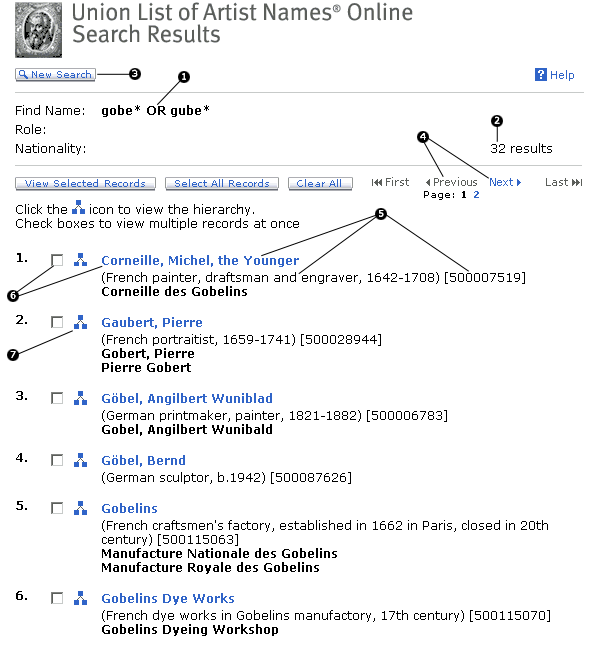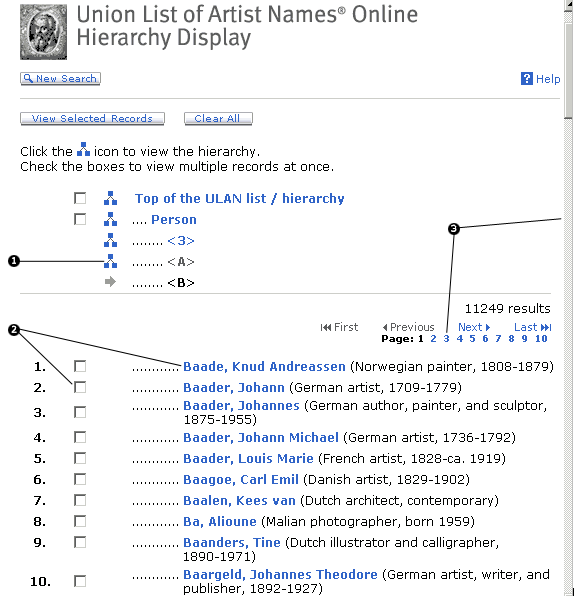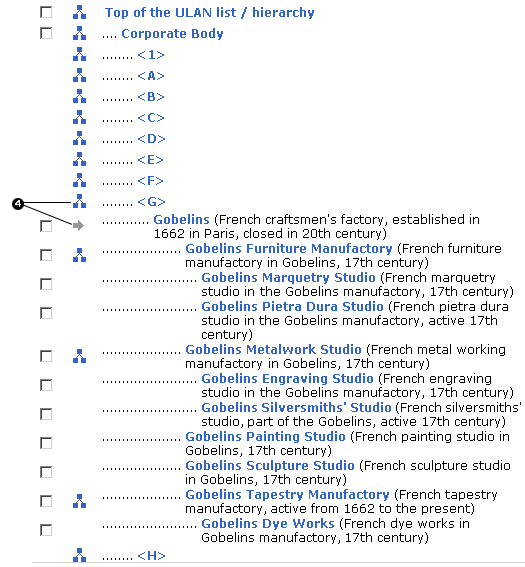 |
How to Use the Search Screen
- Artist names may include names and appellations for any person or group of people (i.e., manufactory, workshop, firm, or other group of people working together) involved in the design, creation, or production of visual arts or architecture. Names for some art patrons are also included. The ULAN is not comprehensive. It grows over time through contributions.
Queries Using Find Name
- To find names in the ULAN, type a personal or corporate name in the Find Name field, using the guidelines described below. To learn more about what kinds of names are included in the ULAN, see About the ULAN: Information in the Record (Fields).
- Case and punctuation: Names may be entered in upper or lower case, with or without spaces and punctuation.
 |
|
|
 |
Examples: |
|
 |
Find Name: |
Vincent van Gogh |
 |
Find Name: |
VINCENT VAN GOGH |
 |
Find Name: |
vincentvangogh |
 |
|
- Diacritics: Names may be entered with or without diacritics (in the example below, querying with the accent will retrieve the same results as typing the "e" without the accent).
 |
|
|
 |
Examples: |
|
 |
Find Name: |
Jean-Siméon Chardin |
 |
Find Name: |
Jean-Simeon Chardin |
 |
|
- Nicknames: In general, do NOT include words from the artist's real name and his or her nickname or any other parenthetical name in the same query. The nickname is typically considered a separate name.
 |
|
|
 |
Examples: |
|
 |
Find Name: |
El Greco |
 |
Find Name: |
Domenikos Theotokopolous |
 |
Find Name: |
Domenikos Theotokopolous (El Greco) [NOT this; including the nickname will retrieve zero results]
|
 |
|
- Boolean operators: You may use AND or OR in the Find Name field. These Boolean operators must be in ALL CAPS.
 |
|
|
 |
Examples: |
|
 |
Find Name: |
Frank AND Wright |
 |
Find Name: |
Thomson OR Thompson |
 |
|
- Parentheses: You may use parentheses with AND and OR. When using both AND and OR in the same query, parentheses should be used in order to retrieve meaningful results.
 |
|
|
 |
Examples: |
|
 |
Find Name: |
(Titian OR Rubens) AND Peale |
 |
Find Name: |
(Dyck OR Dijk) AND (Anthony OR Antoine) |
 |
|
- Wildcard: You may use the asterisk (*) as a wildcard for right-hand truncation. You may also use a wildcard in the middle of the name. Left-hand truncation (leading truncation) is not allowed. You may use AND or OR with wildcards. Truncation of words with only a few letters (e.g., Al*) will generally produce too many results and you will be prompted to narrow your search.
 |
|
|
 |
Examples: |
|
 |
Find Name: |
Hofman* |
 |
Find Name: |
G*gin |
 |
Find Name: |
Jan AND (Breu* OR Brue*) |
 |
|
- Quotes: You may use quotes to find an exact match on your phrase. When you do not use quotes, the search engine looks for individual keywords that match your query. Using quotes is a good way to limit your search when the name is also a keyword in many multiple-word names (e.g., the example below will retrieve the single artist known simply as "Raphael," not artist names with other keywords, such as "Georg Raphael" or "Raphael Collin").
 |
|
|
 |
Example: |
|
 |
Find Name: |
"Raphael" |
 |
|
- Quotes with Booleans: You may use quoted phrases with OR; however, you may not use quoted phrases in parentheses. Note that quoted phrases would produce zero results with AND because such a query would be illogical. You may combine quoted and unquoted phrases.
 |
|
|
 |
Examples: |
|
 |
Find Name: |
"Raphael" OR "Perugino" |
 |
Find Name: |
Lucas van Leyden OR "Rembrandt" |
 |
|
- Stemming: Stemming may be enabled by placing a dollar sign ($) in front of the keyword that you wish to retrieve. Stemming allows queries for the word and its morphological variants. For example, $publish would retrieve all names that contain the word publish or its grammatical variants in English: publishes, publishing, publisher. Stemming is a feature designed to work best with English words; it is only occasionally useful with personal and corporate names. You may use stemming with AND and OR. You may use stemming with parentheses. Stemming would produce zero results when used with quotes because such a query would be illogical. Stemming of common words in names will probably produce too many results and you will be prompted to narrow your search.
 |
|
|
 |
Examples: |
|
 |
Find Name: |
$Publish |
 |
Find Name: |
$Publish AND (Jackson OR Jakeson) |
 |
|
Queries Using Role:
- When using Find Name, you may narrow your query (i.e., reduce the number of results) by also listing a Role, which is a word or phrase that describes a significant professional or official role of the artist (e.g., painter, sculptor, architect). To learn more about roles in the ULAN, see About the ULAN: Information in the Record (Fields).
- You may not use AND, OR, or wildcards in the Role field. You may search for multiple roles by placing a comma between roles.
- Using the Role field without Find Name will typically result in the retrieval of too many artists and you will be prompted to narrow your query.
- You may see a list of valid values for roles by clicking on Lookup. In the Lookup window, note that you may check multiple boxes to perform a search on multiple roles in the same query.
Queries Using Nationality:
- When using Find Name, you may narrow your query (i.e., reduce the number of results) by also listing a Nationality. You may use all three fields, Find Name, Role, and Nationality together to narrow a query.
- You may not use AND, OR, or wildcards in the Nationality field. You may search for multiple nationalities by placing a comma between nationalities.
- Using the Nationality field without Find Name will generally result in the retrieval of too many artists and you will be prompted to narrow your query. If you do not use Find Name, queries using both Role and Nationality together are more likely to produce a reasonable number of results than using either one alone; however, such queries may also produce too many results if the role and nationality are common (e.g., a search for Role artist and Nationality Italian would not succeed). In the example below, the role and nationality together bring back a manageable number of results.
- You may see a list of valid values for Nationalities by clicking on Lookup. The Lookup list includes nationalities, cultural designations, and ethnicities. In the Lookup window, note that you may check multiple boxes to perform a search on multiple nationalities in the same query.
Searching Tips
- If you are unsure of the spelling of a name, you may use the wildcard (e.g. Rembran*). Only right and middle truncation are supported; left truncation is not allowed.
- If you fail to retrieve the artist you are looking for, try looking for a single keyword, or two keywords with Boolean operators. For example, if a search for Edgar Hilaire Degas does not return the artist you are looking for, try looking for Edgar AND Degas.
- If the name you seek has a character with a diacritical mark and your search was unsuccessful, try typing the character without the diacritic.
- If you have searched for a name in inverted order and your search was unsuccessful, try searching for the name in natural order (e.g., search for Andrea da Firenze rather than Da Firenze, Andrea).
- There is no stop list in The ULAN Online. For example, since the words and and the are not on a stop list, you may search for names such as Currier and Ives and Peter Brueghel the Elder.
- If you wish to use Boolean operators, you must capitalize the AND or OR.
- There is a limit of 5000 results. If you retrieve too many records, narrow your search by 1) including more of the name (include more letters of the name or a second keyword of the name), 2) adding the nationality as a criterion, or/and 3) adding the role as a criterion.
- When you cannot find a record by querying, try browsing through the list/hierarchy. Click on Browse the ULAN Hierarchies below the search box, choose a letter of the alphabet under either Corporate Body or Person, and scroll through the artists with names that begin with this letter.
How to Read the Search Results

 |
 |
|
 |
 |
At the upper left of the Search Results, you will see the criteria that were used to retrieve the results (e.g., in the example above, Find Name was gobe* OR gube*). |
 |
 |
|
 |
 |
At the upper right, you will see the total number of results (32 results in the example above). |
 |
 |
|
 |
 |
You may return to the search screen by clicking New Search. |
 |
 |
|
 |
 |
Use the scroll bar along the right side to see results further down the page. Near the upper right of the page, you will see an indication of the number of pages of results (two pages in the example above) and navigation indicators to go forward or backward through the pages. In the example above, you could click on the number 2 or click Next to go to page two. You could click on First or Last to go to the beginning or end of the set of pages, which is useful when many pages are returned. |
 |
 |
|
 |
 |
The results are arranged in alphabetical order. Each artist or corporate body is represented in the results list by a preferred name and display biography. The preferred name is highlighted (in blue). On the line below the name is the display biography, which comprises the artist's or corporate body's nationality, role, and dates. The number in square brackets is the unique numeric identifier (Subject ID) for the artist in the ULAN database. All names that matched the query are in the results list. If a name that matched the query is not the preferred name, it will be listed under the display biography, in black letters. For example, in result number 1 above, the preferred name for the artist is Corneille, Michel, the Younger; but a variant name, Corneille des Gobelins, matched the query (it has a keyword that matches gobe*) and is displayed in black. |
 |
 |
|
 |
 |
You may view the Full Record Display for any of the results by clicking on the highlighted (blue) preferred name. You may view multiple records at once by checking the boxes at the left and clicking View Checked Records at the top of the screen. You may clear checks from the boxes by clicking Clear All at the top of the screen. |
 |
 |
|
 |
 |
You may browse for additional artists by clicking on the hierarchy icon to the left of the name. |
 |
 |
|
How to Read the Full Record Display
- To go to a full record for a ULAN artist, you must be in a results list or the hierarchical/browsing display. From either display, select the artist by 1) clicking on the highlighted (blue) name or 2) checking the checkboxes (to the left of the names) for one or more artists and then clicking View Checked Records.
- Brief descriptions of information in a ULAN record appear below. A minimum record has a Name, Subject ID, Record Type, Nationality, Display Biography, and Role. For a more complete explanation of the data in a ULAN record, see About the ULAN: Information in the Record (Fields).
- Subject ID: Unique numeric identification for the ULAN record.
- Record Type: Type designation that characterizes the ULAN record (person, corporate body, guide term, etc.); you may click on the highlighted word(s) to see the definition of the terminology.
- Label: Brief text identification of the artist, comprising the preferred name and display biography (in parentheses). Click on the hierarchy icon to browse for other artists.
- Note: The Descriptive Note is a note that describes the artist's career or biography.
- Names: Names and appellations referring to the artist, including a preferred name and variant names. Names are displayed with various flags (e.g., "V" in the example below; click on the flag to see its meaning).
- The language of the names may be included. A "P" following the language indicates that this is the preferred name in that language.
- The preferred name for most modern artists is the inverted form (index name), with last name first; this name is appropriate for use in alphabetical lists. A display name may be flagged; this is the preferred name in natural order, to be used in wall labels and other displays.
- Display Date for the name: A note referring to a date or other information about the name.
- Nationality: A reference to the nationality (not necessarily legal citizenship), culture, or ethnic group associated with the artist or corporate body. There may be multiple nationalities.
- Roles: Words or phrases describing a role or characteristic of the artist (e.g., architect, goldsmith).
- Display Date for Role: A note referring to a date or other information about the artist relative to the role (e.g., for the role court artist for Augustinus Terwesten below).
- Gender: The sex of the artist, male, female, or unknown. For corporate bodies, the gender is not applicable.
- Birth and Death Places: Locations where the artist was born or died, or where the corporate body was established. Click on the highlighted (blue) place name to go to the TGN record for the place.
- Events: Places and dates for pertinent events in the artist's life. This may include the event active, particularly when the locus of activity differs from the nationality, when an artist was active only late in life, or his or her birth date is unknown. Click on the highlighted (blue) place name to go to the TGN record for the place.
- Related People or Corporate Bodies: Associative relationships (i.e., non-hierarchical references) to other artists in the ULAN, particularly professional relationships. Familial relationships are included for families of artists. Each reference comprises a relationship type plus the preferred name, role, parent string, and subject ID for the related artist. The example below illustrates related artists for Siena. Click on the highlighted (blue) name of the related artist to go to his or her record.
- Display Date for the related person or corporate body: A note referring to a date or other information about the relationship between the two artists. The example below notes when George Harvey studied with Allan William.
- List/Hierarchical position: A display that allows you to see the context of the record or to click on the icon and browse the ULAN. For individual artists, the broader context is usually simply Person.
- For corporate bodies, the hierarchical context may be a broader division of a department or firm.
- Display Date for the parent: A note referring to a date or other information about the link between a corporate body and its broader context (e.g., from 1668 until early 18th cent. in the example above). If a link is historical (rather than current), it is marked with an (H).
- Biographies: Display biographies and the contributors that submitted them. One biography is marked preferred for the record, to serve as a default for displays.
- Sources and Contributors: Initials, abbreviations, or acronyms for the contributing projects or institutions (in square brackets), combined with bibliographic sources. Sources and Contributors may be associated with the record in three ways: with the names, with the record as a whole (subject), and with the note (descriptive note). For the names, when the contributor is followed by the word Preferred (e.g., BHA Preferred), it means that this name is preferred by that institution. Click on the initials of the contributor or the brief citation of the source to see a fuller description of the contributor or source.
How to Navigate the Hierarchy Display
- You may go to the Hierarchy Display by clicking on the hierarchy icon in a results list or in a full record display. You may also access it by clicking on Browse the ULAN Hierarchies from the search screen.


|
 |




